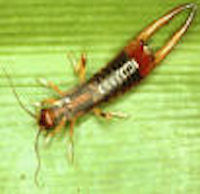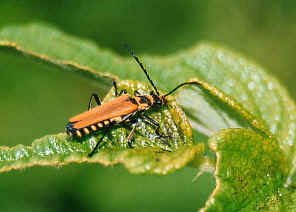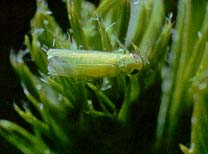|
Insects are plentiful this year. I don't think we can blame it
on the mild winter, but they have great systems of survival.

One insect of note with the wet weather is the earwig. Earwigs
tend to be in high-organic areas, as they feed primarily on dead
insects and plant material. However, they can and do eat live
plant material such as marigolds, zinnias, strawberries and
others. They may be a prime suspect if you notice damage but
never see any insects during the day. Control can be obtained
with insecticides such as bifenthrin or permethrin.

Leatherwing beetles, or soldier beetles, are now present
where linden trees are pollinating. They look like pale
lightning bugs but don't have the light. These beetles are
elongate, soft-bodied and about one-half-inch long. Colors of
soldier beetles vary from yellow to red, with brown or black
wings or trim. A common and easily spotted species is the
Pennsylvania leatherwing, which is yellow with one large black
spot on each wing. Most larvae are carnivorous, feeding on
insects in the soil. Larvae overwinter in damp soil and debris
or loose bark. The adults are also predators, eating
caterpillars, eggs, aphids and other soft-bodied insects. They
will alternatively eat nectar and pollen if no insects are
around. They do not damage plant foliage. Adults are often found
on flowers such as goldenrod, where they lie in wait for prey,
feed on pollen and mate. Since soldier beetles are beneficial,
it is inadvisable to kill them.
[to top of second column]

 |


Potato leafhopper populations have exploded in the
last week. These are the small, pale green, wedge-shaped insects we
often see around lights at night. The main garden crop they affect
is -- guess this one -- potatoes. They suck sap and inject a toxin
back into the plant. The first sign is a yellow "V" at the tip of
the leaf. These areas then turn brown or black. Entire plants or
branches can die from these tiny insects. Control with Sevin,
bifenthrin or permethrin.
The last insect to discuss is the bagworm. Bagworms
are notorious pests of evergreens such as spruce trees. We're about
to June 15, the traditional date for control. With the warmer
spring, we may run a few days ahead of normal. The idea is to have
all the eggs hatched before treatment but not wait until the
bagworms are almost mature. For control, the traditional standby has
been Sevin, but the Bt products such as Dipel and Thuricide have
really taken their share of the market the past several years. The
Bt products have several good points, including safety to mammals
and toxicity to larger bagworms. Since they are bacteria that affect
only the larvae of moths and butterflies, it does take a while for
the bacteria to build up to the point where they can kill the
bagworm. If you are in doubt about whether you have bagworms, check
your trees and shrubs around June 15. You can actually see the small
bags as the larvae build them. They become very noticeable at about
one-sixteenth of an inch long. Treat bagworms early, since larger
ones are more difficult to control.
[By
JOHN FULTON,
University of Illinois Extension, Logan County] |